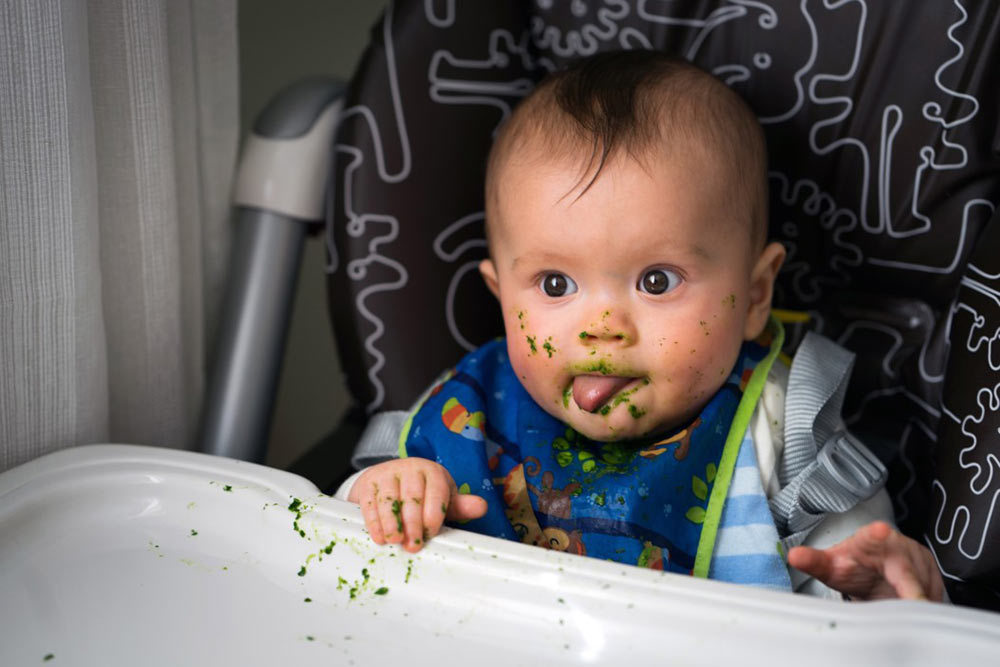15 Things Experts Wish You Knew About Feeding Your Child

From bottles to solids and all the biology in between.
Medical Experts: Corey Baker, MD; Vincent Ho, MD; Kelly Komisaruk, MEd, CCC-SLP; Grace MacNair, IBCLC; Lauren Manaker, MS, RDN, LD, CLEC; Danielle McDaniel, MOT, OTR/L; Navya Mysore, MD; Mallory Whitmore, MEd, CIFT
Mealtimes with little ones can be messy, confusing, and downright overwhelming. We spoke to doctors and feeding therapists for their advice for getting your kiddo to eat and how you can feel comfortable throughout the process.
Infant Feeding
Store brands are the same
When it comes to baby formula, most stores have the same—well—formula. The only difference is the name and packaging. “Store-brand formulas are made by the same manufacturer and have the same recipe store-to-store,” says Mallory Whitmore, MEd, CIFT founder of The Formula Mom on Instagram. That means Target’s Up&Up Gentle formula is the same as Walmart’s Parent’s Choice Gentle formula and Kroger’s Comforts Gentle formula.
This information is always helpful but especially significant during formula shortages in the United States. If your preferred formula is out of stock, you can feel good knowing another retailer carries the same product.
A higher price does not indicate a better product
Baby formulas are regulated by the U.S. Food and Drug Administration (FDA), and each of them must meet the same nutrient requirements. So, what’s with the range in prices? Whitmore explains that a higher price tag generally accounts for “designer ingredients” that the FDA does not require, such as prebiotics. “Formula marketing has led parents to believe [these ingredients] are crucial for their infant’s development,” she says, “Even though research is mixed and not conclusive that these things are beneficial.”
There are many causes for nipple pain
“Nipple pain isn’t normal,” says Grace MacNair, IBCLC, an infant feeding support specialist. “There is nearly always an underlying cause.”
Your newborn may have trouble latching, tongue ties, tension in their face, neck, hips, body, and jaw, difficulty moving their tongue correctly, or more. The nursing parent may also be experiencing vasospasm, a spasm in the blood vessels to the nipple that then reduces blood flow and milk flow, or have hypersensitivity in their nipples due to trauma, psychiatric conditions, and pain disorders. So suffer in pain! Both you and your baby can be screened to find the reason (and solution) for the discomfort.
Use inclusive terminology
There are more inclusive terms for breastfeeding, such as chestfeeding or bodyfeeding. Both of these are more welcoming to and respectful of nonbinary and transgender parents who lactate. MacNair particularly likes “bodyfeeding” because feeding an infant is a complex physiological process that requires the entire body and multiple body systems. “I think bodyfeeding is a great term to use for everybody because it sure feels like you’re feeding your baby with your whole body,” she says.
Nipple-bottle confusion is a myth
So long as they don’t have an underlying feeding problem, newborns should be able to move smoothly between bottle and bodyfeeding. After all, MacNair says, infants have reflexes to eat and are not yet at the age of choice. “It’s not until about 3 to 4 months that they start to have the brain development to create preferences,” she says. “Newborns can’t create preferences, so when we think about nipple confusion or bottle confusion, that’s developmentally incorrect.”
She recommends introducing a bottle within the first four weeks because often, by six weeks, babies may not love taking a bottle. If they’ve never taken a bottle by 3 or 4 months of age, it can be really challenging to get them to start.
Starting Solids
Follow their lead
Look for indications that your baby is ready to start solids. This usually happens between 5 and 6 months of age, says Danielle McDaniel, MOT, OTR/L, an occupational therapist and owner of Little Wonders Pediatric Therapy in Charlotte, North Carolina.
McDaniel encourages parents to wait until their infant can sit upright in their highchair independently and with good stability. “Signs of readiness include reaching for food, showing excitement at seeing food, opening their mouth with the presentation of a spoon or food, and good head control when seated,” she says.
Exposure is key
Even if your child does not appear to like a food the first time, be sure to give it to them again, says pediatric feeding specialist Kelly Komisaruk MEd, CCC-SLP. It may take more than a dozen times for a baby or toddler to see and experience a new food before they feel comfortable eating it. “Don’t force it,” she says. “But keep placing it on their plate and offering it. You just may be surprised!”
And remember that spitting something out may not mean your baby doesn’t like the food. Babies often use their tongue to push out food simply because it is new and strange, McDaniel explains. “Imagine if, for your whole life, you’d been fed milkshakes, then suddenly someone wants you to eat peas,” McDaniel says. “It’s shocking and takes some getting used to but should not be interpreted as dislike via spitting out or making a face.”

Diversify options
Once they start eating solids, Vincent Ho, MD, a gastroenterologist in Sydney, Australia, and author of The Healthy Baby Gut Guide, recommends giving your baby a wide range of foods with different flavors and textures. “It’s important to not restrict their food choices to the foods that you like,” he says.
Registered dietician Lauren Manaker, MS, RDN, LD, CLEC, encourages parents to remember that beyond the nutrients found in produce, they should also include iron, zinc, protein, and fat in their baby’s diet. “While fruits and veggies are appropriate and popular first food choices, appropriately prepared beef, seafood, chicken, and eggs can all be offered to a baby who is eating solids as well,” she says.
Introduce allergens
Eek! We know! Even though it can feel nerve-wracking, Dr. Ho encourages parents to incorporate allergenic foods, such as peanut butter, into their child’s diet. Research has shown that early introduction of food allergens reduces the incidence of childhood food allergens. You can may even feel reassured knowing that you are exposing your child to an allergen in a controlled environment, under your watchful eye, rather than them having a random exposure while on a playdate.
Doctors at Arnold Palmer Hospital for Children in Orlando, Florida, recommend introducing foods one at a time every few days and watching for reactions such as vomiting, hives, itching, or swelling of the lips, tongue, or mouth, wheezing, or difficulty breathing. Start with a small amount and build up to a full serving if no reaction occurs. If they do have a reaction, seek immediate medical attention.
Keep mealtimes fun
You probably don’t just sit and stare while eating, and your little one shouldn’t have to either. Komisaruk suggests using bubbles, simple toys, peek-a-boo, or other means to engage your baby while they are eating. “Remember, toddlers learning to eat is not simply about getting calories in,” she says, “but about learning to love to eat and enjoy the social aspect of sharing meals.”
And even though older kids are often told not to play with their food, let your baby make a mess. Mashing, smearing, and throwing food are normal and good for learning to enjoy food. “Messy eating has a ton of benefits,” Komisaruk says. It provides a variety of sensory experiences and promotes fine motor skills, and again, it makes eating fun and exploratory. We know wiping up their tray, hands, face, and probably the floor is a pain for you, but letting them get messy is a win for their development!
The Mechanics of it all
Their belly is teeny tiny
You were probably tracking the size of your little bean in utero, but do you know the size of their stomach now that they’re finally here? “A newborn’s stomach is about the size of a cherry,” says Manaker. “By day two, it’s the size of a walnut.”
This small volume can certainly play a role in spit-up or mealtime fussiness. If a baby isn’t tolerating a feeding or is regurgitating much of it, it may be that they’ve reached their tummy’s capacity.
Frequent spit-up is normal
Spit-up should not involve forceful muscle contractions the way vomiting would, nor should it cause your baby distress or discomfort. Even still, all that reversed liquid can worry (or gross out) a new parent. Luckily, spit-up is usually more of a laundry problem than a medical one. “It may seem like a lot, but healthy 1–5-month-olds spit up often,” says Corey Baker, MD, a gastroenterologist at Connecticut Children’s.
Reflux can be managed
Similar to spit-up is reflux, but it usually happens in larger quantities and may cause your baby some discomfort during feedings. Mild reflux is common in infants and typically peaks around 4 months of age. For babies with reflux, Navya Mysore, MD, a family physician at One Medical in New York, New York, suggests incorporating a small amount of cereal with your baby’s bottles to help with reflux. “The idea is that by adding a small amount of more solidified food, you help to keep the milk or formula down and prevent regurgitation,” she says.
If your baby is refusing feedings, seems to be in pain while feeding, has poor weight gain, or has spit-up with blood or greenish color, these can be signs that their reflux is not normal and should be discussed with their pediatrician. Additionally, it’s helpful knowing that anti-reflux medications exist, and while they do not stop reflux from happening, they can help keep baby more comfortable, Dr. Baker says.
Gagging is often normal
We know it makes you nervous, but gagging is part of normal development. When babies are learning how to eat, there are a lot of things to coordinate, McDaniel says. “They have to learn to chew, move food around in their mouth, and to breathe while coordinating this, usually with their mouth open,” she explains. “Gagging is a safety mechanism that expels food either too large or not ready for swallowing.”
That said, it is not normal if gagging is regularly followed by vomiting or if your child turns red for a period of time before gagging. Both should be discussed with their pediatrician.
Change their diaper strategically
One technique that was especially helpful for Dr. Mysore when her sons were newborns was changing their diapers in the middle of a feed instead of before. “Often, infants fall asleep during a feed even though they are not finished,” she says. “Changing their diaper in the middle helps to keep them up, and you can finish the feed after the change.” Sure, you might have to change it again soon after, but at least you know they are full and hydrated.
If you ever worry that your little one’s feeding isn’t normal, talk with their pediatrician. If all is good (and we hope it is!), we wish you and your babe bon appétit!
This article has been updated since its original publishing in 2022.







